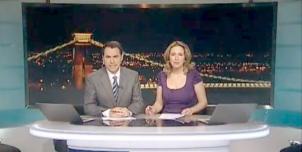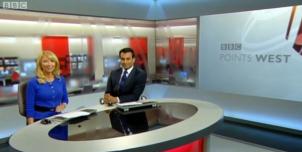Full Freeview on the Mendip (Somerset, England) transmitter
| Google Streetview | Google map | Bing map | Google Earth | 51.237,-2.626 or 51°14'12"N 2°37'33"W | BA5 3LB |
The symbol shows the location of the Mendip (Somerset, England) transmitter which serves 720,000 homes. The bright green areas shown where the signal from this transmitter is strong, dark green areas are poorer signals. Those parts shown in yellow may have interference on the same frequency from other masts.
This transmitter has no current reported problems
The BBC and Digital UK report there are no faults or engineering work on the Mendip (Somerset, England) transmitter._______
Digital television services are broadcast on a multiplexes (or Mux) where many stations occupy a single broadcast frequency, as shown below.
64QAM 8K 3/4 27.1Mb/s DVB-T MPEG2
DTG-12 QSPK 8K 3/4 8.0Mb/s DVB-T MPEG2
H/V: aerial position (horizontal or vertical)
Which Freeview channels does the Mendip transmitter broadcast?
If you have any kind of Freeview fault, follow this Freeview reset procedure first.Digital television services are broadcast on a multiplexes (or Mux) where many stations occupy a single broadcast frequency, as shown below.
64QAM 8K 3/4 27.1Mb/s DVB-T MPEG2
DTG-12 QSPK 8K 3/4 8.0Mb/s DVB-T MPEG2
H/V: aerial position (horizontal or vertical)
Which BBC and ITV regional news can I watch from the Mendip transmitter?

ITV West Country News (East) 0.9m homes 3.4%
from Bristol BS4 3HG, 23km north (11°)
to ITV West region - 61 masts.
All of lunch, weekend and 50% evening news is shared with West Country (West)
Are there any self-help relays?
| Cheddar | Transposer | 15 km E Weston-super-Mare | 1674 homes |
| Luccombe | Active deflector | 6 km w Minehead | 38 homes |
How will the Mendip (Somerset, England) transmission frequencies change over time?
| 1984-97 | 1997-98 | 1998-2010 | 2010-13 | 2013-18 | 2013-17 | 27 Feb 2018 | |||
| C/D E | E | E | C/D E | C/D E T | W T | W T | |||
| C30 | _local | ||||||||
| C32 | BBCA | ||||||||
| C33 | com7 | com7 | |||||||
| C34 | D3+4 | ||||||||
| C35 | com8 | com8 | |||||||
| C36 | ArqB | ||||||||
| C37 | C5waves | C5waves | |||||||
| C48 | SDN | SDN | SDN | SDN | |||||
| C49tv_off | BBCA | BBCA | |||||||
| C51tv_off | LBS | LBS | |||||||
| C52tv_off | ArqB | ArqB | ArqB | ||||||
| C54tv_off | C4waves | C4waves | C4waves | D3+4 | D3+4 | D3+4 | |||
| C55tv_off | com7tv_off | ||||||||
| C56tv_off | ArqA | ArqA | ArqA | COM8tv_off | |||||
| C58tv_off | BBC1waves | BBC1waves | BBC1waves | BBCB | BBCB | BBCB | |||
| C61 | ITVwaves | ITVwaves | ITVwaves | BBCA | |||||
| C64 | BBC2waves | BBC2waves | BBC2waves |
tv_off Being removed from Freeview (for 5G use) after November 2020 / June 2022 - more
Table shows multiplexes names see this article;
green background for transmission frequencies
Notes: + and - denote 166kHz offset; aerial group are shown as A B C/D E K W T
waves denotes analogue; digital switchover was 24 Mar 10 and 7 Apr 10.
How do the old analogue and currrent digital signal levels compare?
| Analogue 1-4 | 500kW | |
| Analogue 5 | (-6dB) 126kW | |
| SDN, ARQA, ARQB, BBCA, D3+4, BBCB | (-7dB) 100kW | |
| com7 | (-8.4dB) 72.4kW | |
| com8 | (-8.6dB) 69.1kW | |
| Mux 1*, Mux 2*, Mux A*, Mux B*, Mux C*, Mux D*, LBS | (-17dB) 10kW |
Which companies have run the Channel 3 services in the Mendip transmitter area
|
|
Wednesday, 3 April 2013
Michael Perry
6:42 PM
6:42 PM
To Dave Lindsay
No change to any other services at all on either receiver, testing software scans of stick output show 100% on all multiplexes. Only those on Ch 49 (ie BBCA multiplex) are affected.
| link to this comment |
J
jefferson6:50 PM
no signal still
but got bbc on analog witch was very poor befor
first time ive used atv on this telly
4 years old in may
| link to this comment |
J
John Crabb7:19 PM
Chard
To Michael Perry: Thanks for that info Michael, very interesting. Is there a book that I can read all this practical stuff up in?
In addition to fiddling with the cable length, I have now installed a new wideband, high-gain aerial. This did not initially seem to make much diffence over my ancient C/D Yagi. What finally made it all click into place was moving the HDMI cable coming from the HDD to a second socket on the TV. The second one was further from the aerial socket. Is there any possible explanation for this!? The improvement in the signal quality indicator was quite marked.
| link to this comment |
John's: mapJ's Freeview map terrainJ's terrain plot wavesJ's frequency data J's Freeview Detailed Coverage
M
Mazbar7:51 PM
Michael Perry: do you have a wideband aerial or a grouped cd aerial. If the latter 49 is at the end of the normal acceptance of the aerial, if the aerial is good and reception fine there will be no problem but if the signal is medium to poor or you have damage to the coax this could make 49 not work.
| link to this comment |
Michael Perry
8:12 PM
8:12 PM
To Mazbar
That Ch48 is received very strongly means that Ch49 will be as well as long as it is a true C/D group aerial - it is of course as Mendip analogue transmissions were in the C/D band.By definition, Group C/D aerials cover 47 to 69 but if signal strength and quality are high then decoding should be fine - but it isn't on Ch49 and it IS on Ch 48! So aerial is not the problem. BTW, I'm a retired TV engineer.
| link to this comment |
M
Mazbar8:17 PM
Michael Perry: sorry I have only been fitting aerials for over 20 years and as I stated if there is a problem with any part of the aerial the outer ends of the aerial acceptance will be affected the most.
| link to this comment |
Michael Perry
8:21 PM
8:21 PM
To John Crabb
An HDMI cable is carrying digital signals with fast rising edges, so can radiate and that may be picked up by a poor UHF coaxial cable. Always use good quality cables but don't waste money on the 'gold' plated ones - expensive does not mean good quality.
Any electronics book that covers RF signals up to 1000 MHz ought to have something about the relationship between wavelength, frequency and standing waves on cables of a length close to a multiple of the signal wavelength. A rough guide, 300MHz=1m and 100MHz=3m. So for a 600MHz signal avoid any multiple of 0.5m or thereabouts. Hope that helps?
A lot of waffle is spouted about aerials for 'digital' signals. The signal transmitted is an RF carrier so any aerial designed for reception of the frequency range can be considered. Aerial gain and reception angles are also important. A good C/D will suffice for Mendip now but a WB will be needed in a few years- the plan is to move Mendip into the Group A band around 2019!
| link to this comment |
Michael Perry
8:26 PM
8:26 PM
To Mazbar
Sorry I have been teaching engineering staff of a former major TV rental company covering not only the TV sets but aerial systems and satellite systems as well - since 1969! Before that I worked for Philips Electrical. So 59 years experience.
Don't assume that older aerials are deteriorating, it is the enclosed contacts that cause most problems if they are not properly enclosed and sealed. A good quality aerial, well fitted and properly sealed will last for many years. If Ch48 is excellent, it is, then 49 will be as well - it's only 8MHz higher up the band further into the central reception pattern of a C/D aerial.
A C/D group aerial will need replacing before 2019 anyway as they are changing bands for Mendip.
| link to this comment |
M
Mazbar8:40 PM
Michael Perry: if every thing was ok then your bbc would be working have you had your aerial checked by a professional, could you be experiencing interference from another out of area transmitter some signals can carry very very long distances I received rte in sklmersdale, if it is another transmitter try a log aerial this has a narrow acceptance angle. Judging on how long you have been working you are over 75 so don't try going on your roof unless you are ok.
| link to this comment |
Select more comments
Your comment please!






